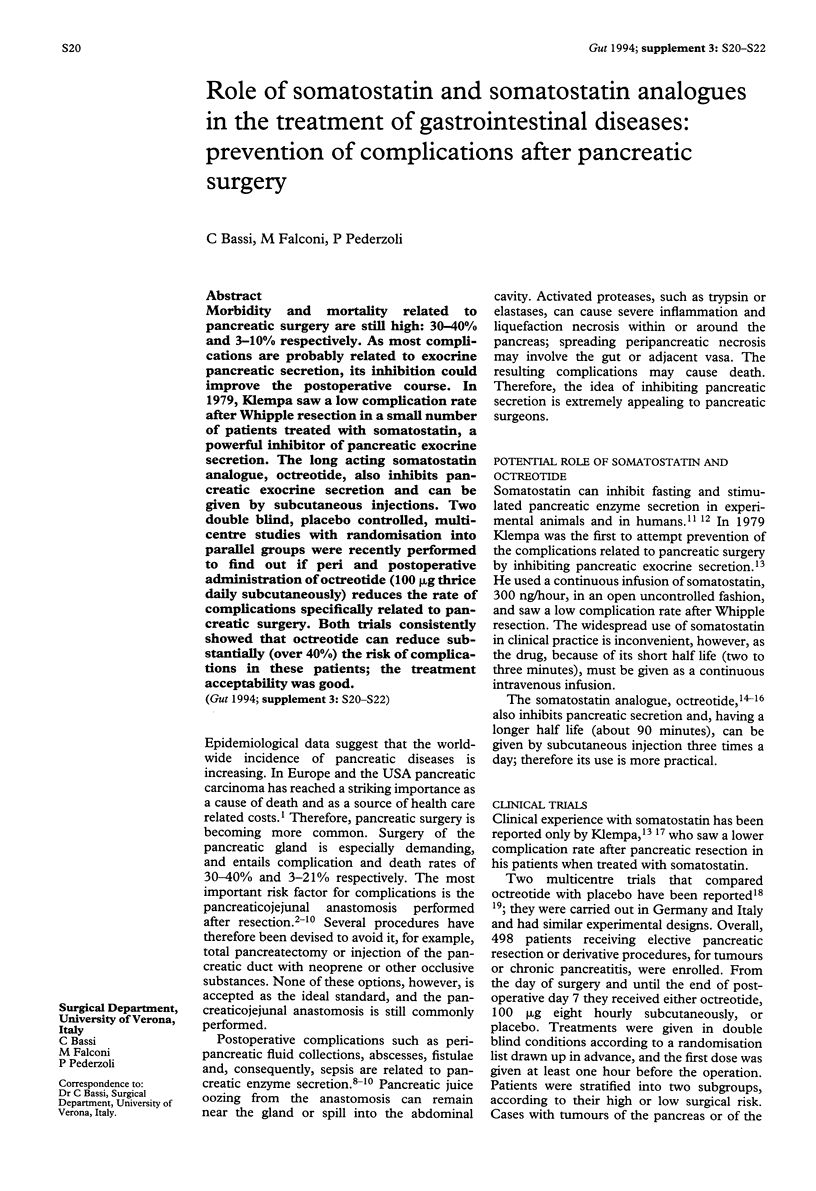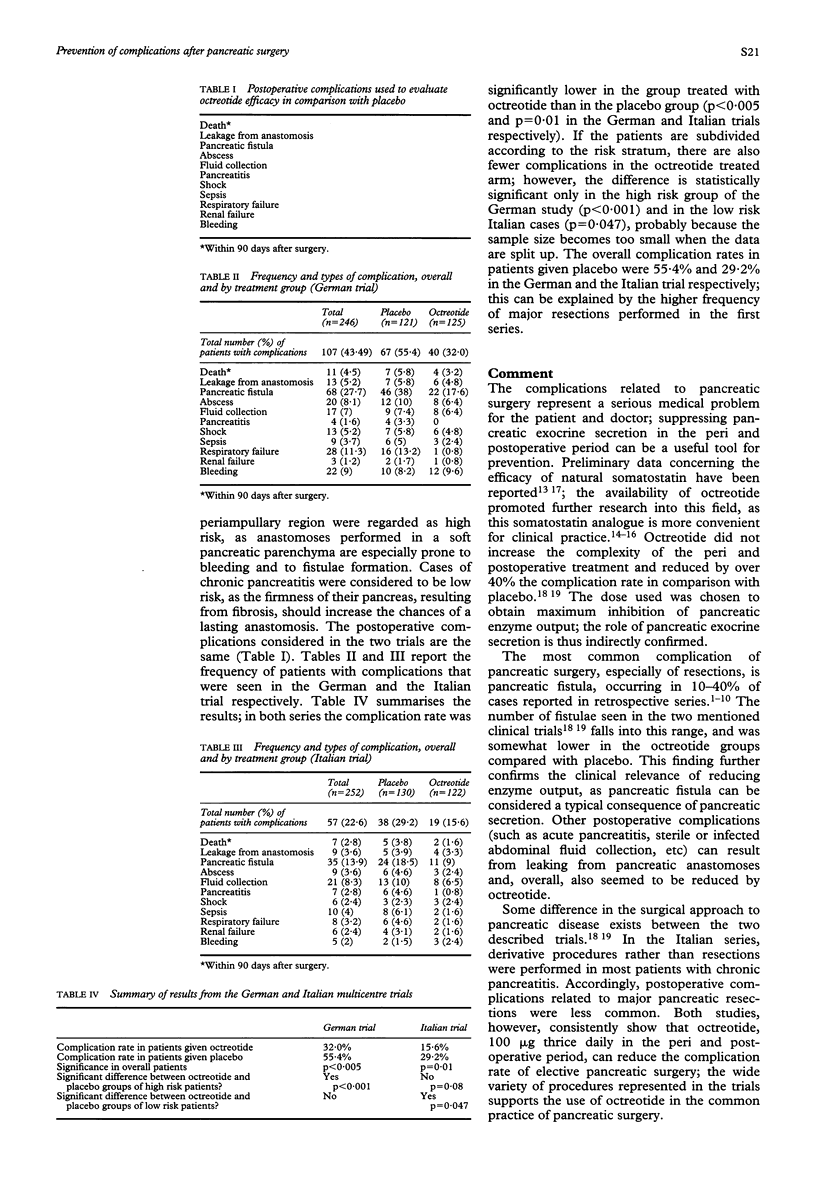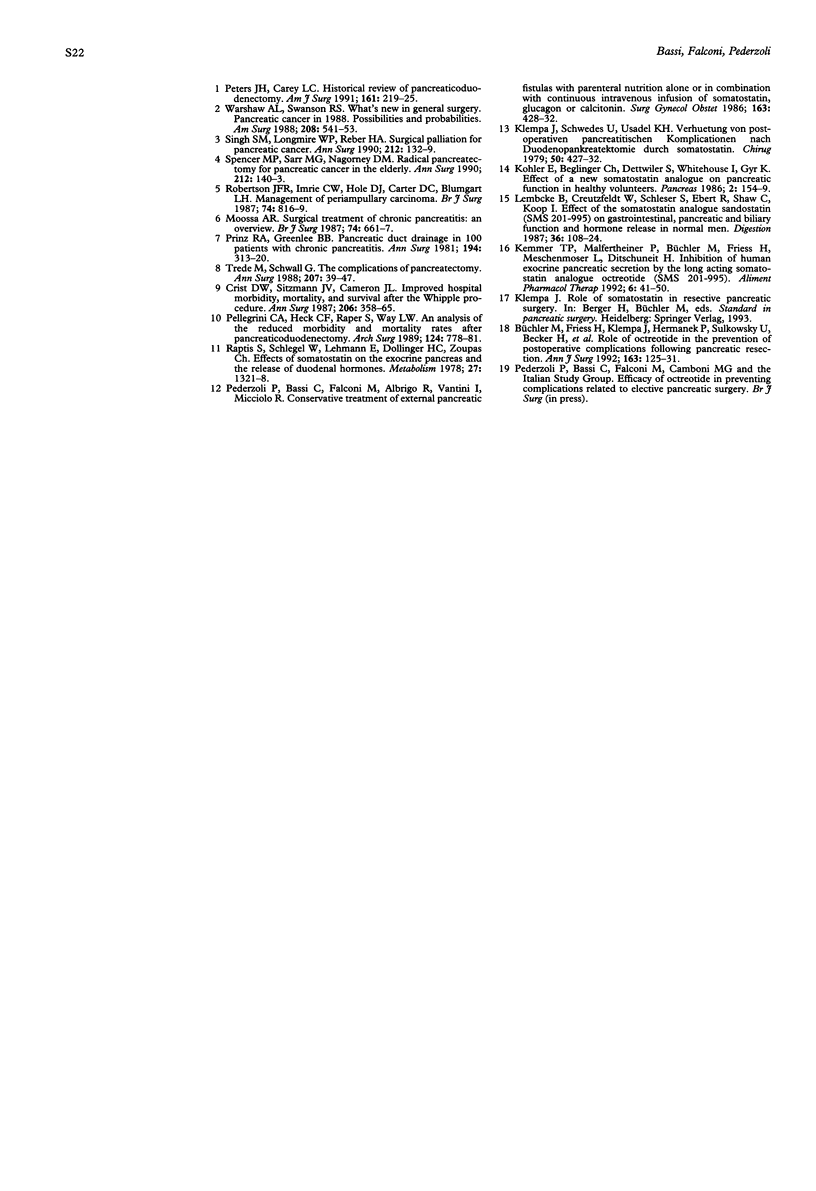Abstract
Morbidity and mortality related to pancreatic surgery are still high: 30-40% and 3-10% respectively. As most complications are probably related to exocrine pancreatic secretion, its inhibition could improve the postoperative course. In 1979, Klempa saw a low complication rate after Whipple resection in a small number of patients treated with somatostatin, a powerful inhibitor of pancreatic exocrine secretion. The long acting somatostatin analogue, octreotide, also inhibits pancreatic exocrine secretion and can be given by subcutaneous injections. Two double blind, placebo controlled, multicentre studies with randomisation into parallel groups were recently performed to find out if peri and postoperative administration of octreotide (100 micrograms thrice daily subcutaneously) reduces the rate of complications specifically related to pancreatic surgery. Both trials consistently showed that octreotide can reduce substantially (over 40%) the risk of complications in these patients; the treatment acceptability was good.
Full text
PDF


Selected References
These references are in PubMed. This may not be the complete list of references from this article.
- Büchler M., Friess H., Klempa I., Hermanek P., Sulkowski U., Becker H., Schafmayer A., Baca I., Lorenz D., Meister R. Role of octreotide in the prevention of postoperative complications following pancreatic resection. Am J Surg. 1992 Jan;163(1):125–131. doi: 10.1016/0002-9610(92)90264-r. [DOI] [PubMed] [Google Scholar]
- Crist D. W., Sitzmann J. V., Cameron J. L. Improved hospital morbidity, mortality, and survival after the Whipple procedure. Ann Surg. 1987 Sep;206(3):358–365. doi: 10.1097/00000658-198709000-00014. [DOI] [PMC free article] [PubMed] [Google Scholar]
- Kemmer T. P., Malfertheiner P., Büchler M., Friess H., Meschenmoser L., Ditschuneit H. Inhibition of human exocrine pancreatic secretion by the long-acting somatostatin analogue octreotide (SMS 201-995). Aliment Pharmacol Ther. 1992 Feb;6(1):41–50. doi: 10.1111/j.1365-2036.1992.tb00543.x. [DOI] [PubMed] [Google Scholar]
- Klempa I., Schwedes U., Usadel K. H. Verhütung von postoperativen pankreatitischen Komplikationen nach Duodenopankreatektomie durch Somatostatin. Chirurg. 1979 Jul;50(7):427–431. [PubMed] [Google Scholar]
- Köhler E., Beglinger C., Dettwiler S., Whitehouse I., Gyr K. Effect of a new somatostatin analogue on pancreatic function in healthy volunteers. Pancreas. 1986;1(2):154–159. doi: 10.1097/00006676-198603000-00008. [DOI] [PubMed] [Google Scholar]
- Lembcke B., Creutzfeldt W., Schleser S., Ebert R., Shaw C., Koop I. Effect of the somatostatin analogue sandostatin (SMS 201-995) on gastrointestinal, pancreatic and biliary function and hormone release in normal men. Digestion. 1987;36(2):108–124. doi: 10.1159/000199408. [DOI] [PubMed] [Google Scholar]
- Moossa A. R. Surgical treatment of chronic pancreatitis: an overview. Br J Surg. 1987 Aug;74(8):661–667. doi: 10.1002/bjs.1800740803. [DOI] [PubMed] [Google Scholar]
- Pederzoli P., Bassi C., Falconi M., Albrigo R., Vantini I., Micciolo R. Conservative treatment of external pancreatic fistulas with parenteral nutrition alone or in combination with continuous intravenous infusion of somatostatin, glucagon or calcitonin. Surg Gynecol Obstet. 1986 Nov;163(5):428–432. [PubMed] [Google Scholar]
- Pellegrini C. A., Heck C. F., Raper S., Way L. W. An analysis of the reduced morbidity and mortality rates after pancreaticoduodenectomy. Arch Surg. 1989 Jul;124(7):778–781. doi: 10.1001/archsurg.1989.01410070028006. [DOI] [PubMed] [Google Scholar]
- Peters J. H., Carey L. C. Historical review of pancreaticoduodenectomy. Am J Surg. 1991 Feb;161(2):219–225. doi: 10.1016/0002-9610(91)91134-5. [DOI] [PubMed] [Google Scholar]
- Prinz R. A., Greenlee H. B. Pancreatic duct drainage in 100 patients with chronic pancreatitis. Ann Surg. 1981 Sep;194(3):313–320. doi: 10.1097/00000658-198109000-00009. [DOI] [PMC free article] [PubMed] [Google Scholar]
- Raptis S., Schlegel W., Lehmann E., Dollinger H. C., Zoupas C. Effects of somatostatin on the exocrine pancreas and the release of duodenal hormones. Metabolism. 1978 Sep;27(9 Suppl 1):1321–1328. doi: 10.1016/0026-0495(78)90066-5. [DOI] [PubMed] [Google Scholar]
- Robertson J. F., Imrie C. W., Hole D. J., Carter D. C., Blumgart L. H. Management of periampullary carcinoma. Br J Surg. 1987 Sep;74(9):816–819. doi: 10.1002/bjs.1800740921. [DOI] [PubMed] [Google Scholar]
- Singh S. M., Longmire W. P., Jr, Reber H. A. Surgical palliation for pancreatic cancer. The UCLA experience. Ann Surg. 1990 Aug;212(2):132–139. doi: 10.1097/00000658-199008000-00003. [DOI] [PMC free article] [PubMed] [Google Scholar]
- Spencer M. P., Sarr M. G., Nagorney D. M. Radical pancreatectomy for pancreatic cancer in the elderly. Is it safe and justified? Ann Surg. 1990 Aug;212(2):140–143. doi: 10.1097/00000658-199008000-00004. [DOI] [PMC free article] [PubMed] [Google Scholar]
- Trede M., Schwall G. The complications of pancreatectomy. Ann Surg. 1988 Jan;207(1):39–47. doi: 10.1097/00000658-198801000-00009. [DOI] [PMC free article] [PubMed] [Google Scholar]
- Warshaw A. L., Swanson R. S. Pancreatic cancer in 1988. Possibilities and probabilities. Ann Surg. 1988 Nov;208(5):541–553. doi: 10.1097/00000658-198811000-00001. [DOI] [PMC free article] [PubMed] [Google Scholar]


